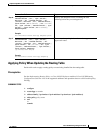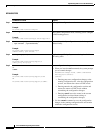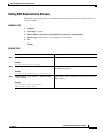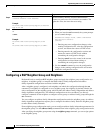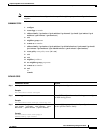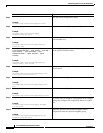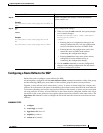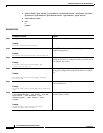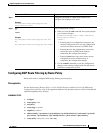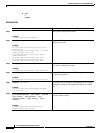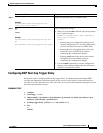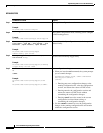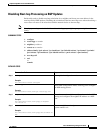
Implementing BGP on Cisco IOS XR Software
How to Implement BGP on Cisco IOS XR Software
RC-79
Cisco IOS XR Routing Configuration Guide
OL-14356-01
Configuring BGP Route Filtering by Route Policy
Perform this task to configure BGP routing filtering by route policy.
Prerequisites
See the Implementing Routing Policy on Cisco IOS XR Software module of Cisco IOS XR Routing
Configuration Guide for a list of the supported attributes and operations that are valid for inbound and
outbound neighbor policy filtering.
SUMMARY STEPS
1. configure
2. route-policy name
3. end-policy
4. router bgp as-number
5. neighbor ip-address
6. address-family {ipv4 unicast | ipv4 multicast | ipv4 labeled-unicast | ipv4 tunnel | ipv4 mdt |
ipv6 unicast | ipv6 multicast | ipv6 labeled-unicast | vpnv4 unicast | vpnv6 unicast}
7. route-policy route-policy-name {in | out}
Step 7
route-reflector-client
Example:
RP/0/RP0/CPU0:router(config-bgp-nbr-af)#
route-reflector-client
Configures the router as a BGP route reflector and
configures the neighbor as its client.
Step 8
end
or
commit
Example:
RP/0/RP0/CPU0:router(config-bgp-nbr-af)# end
or
RP/0/RP0/CPU0:router(config-bgp-nbr-af)# commit
Saves configuration changes.
• When you issue the end command, the system prompts
you to commit changes:
Uncommitted changes found, commit them before
exiting(yes/no/cancel)?
[cancel]:
–
Entering yes saves configuration changes to the
running configuration file, exits the configuration
session, and returns the router to EXEC mode.
–
Entering no exits the configuration session and
returns the router to EXEC mode without
committing the configuration changes.
–
Entering cancel leaves the router in the current
configuration session without exiting or
committing the configuration changes.
• Use the commit command to save the configuration
changes to the running configuration file and remain
within the configuration session.
Command or Action Purpose



